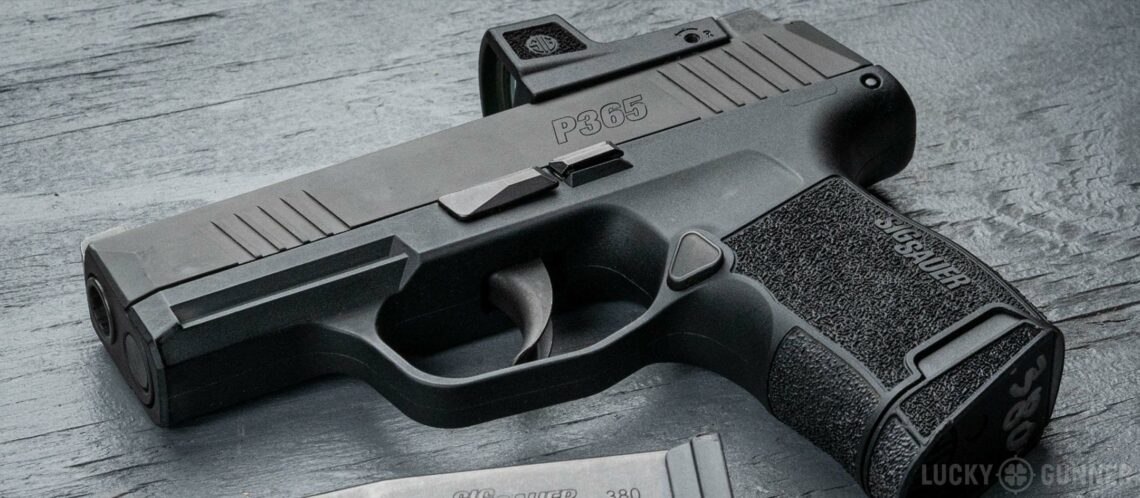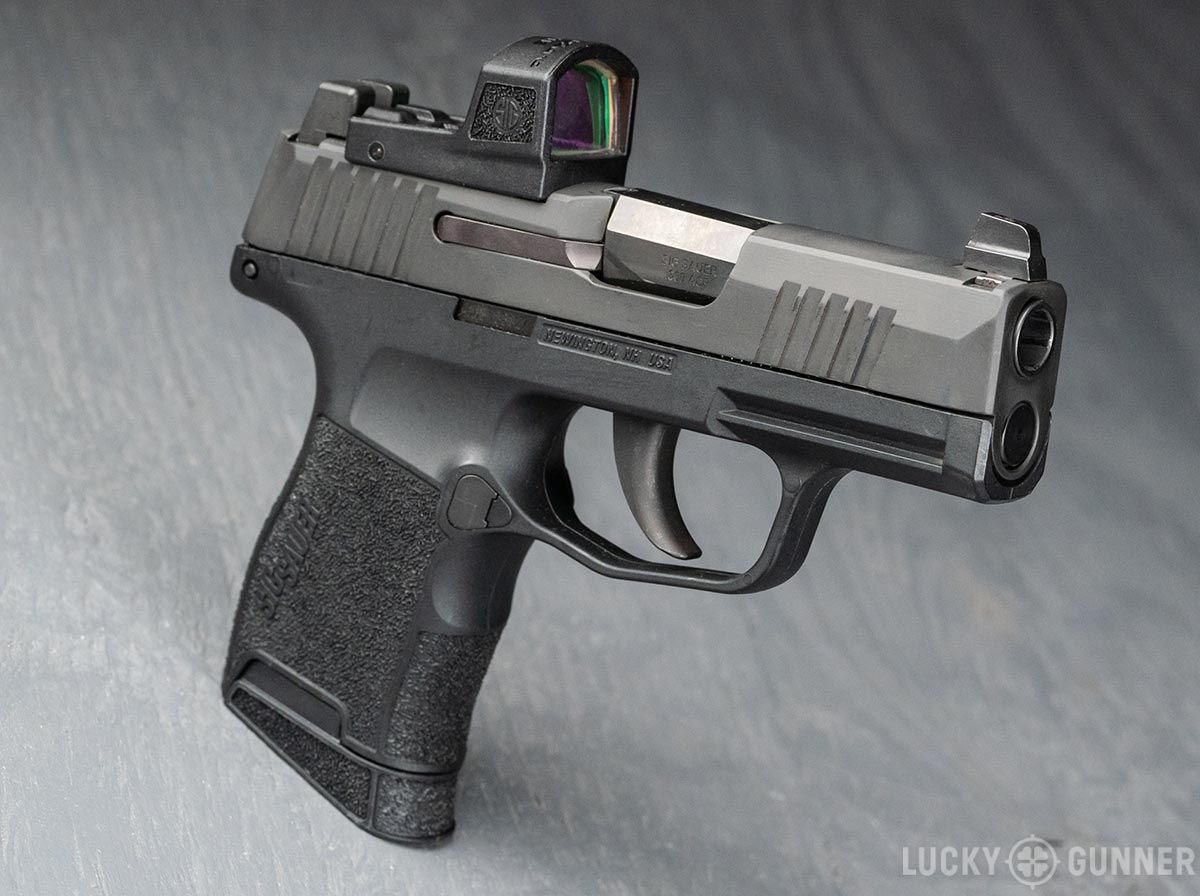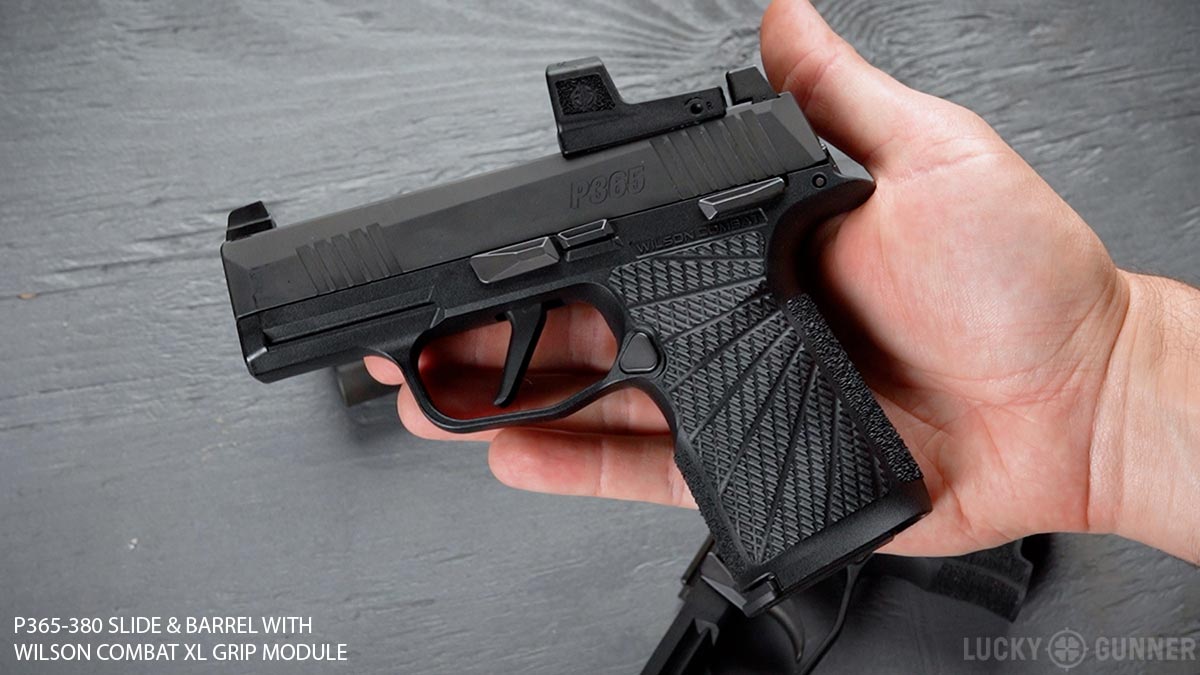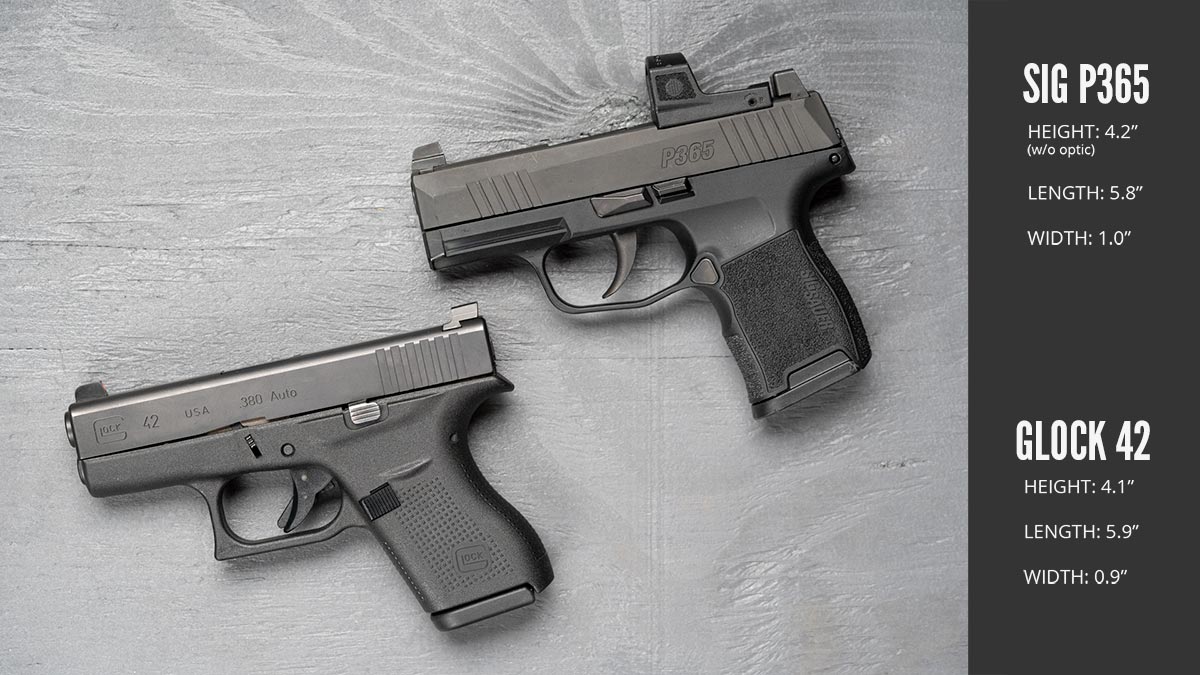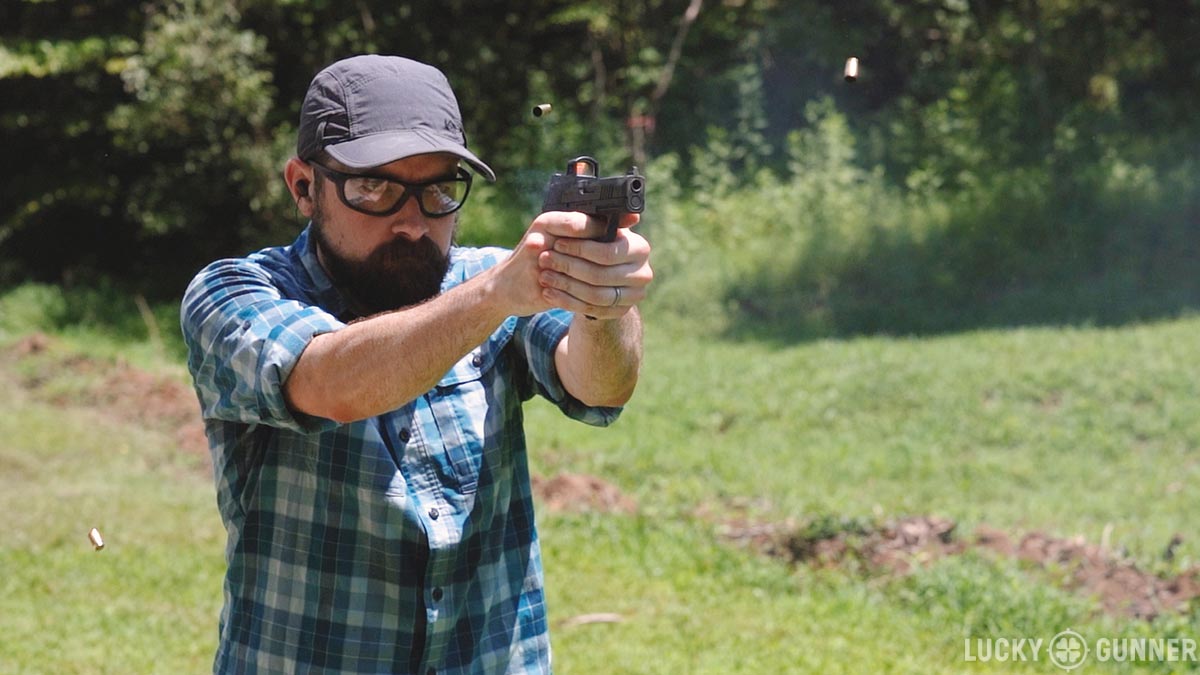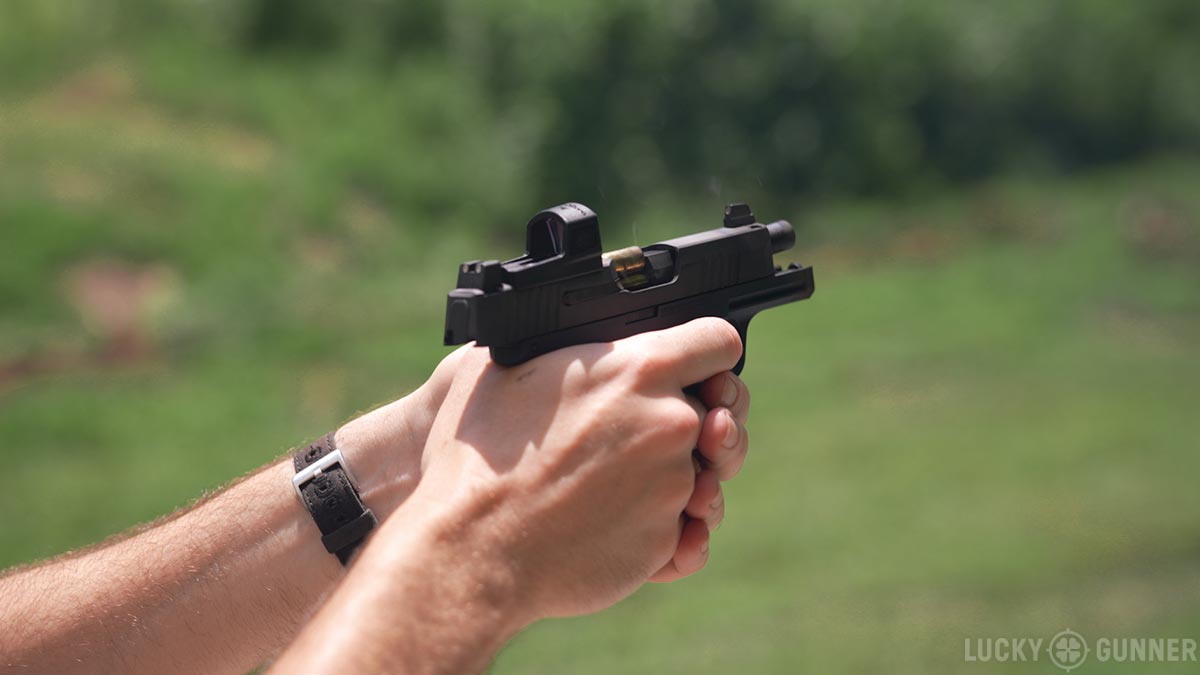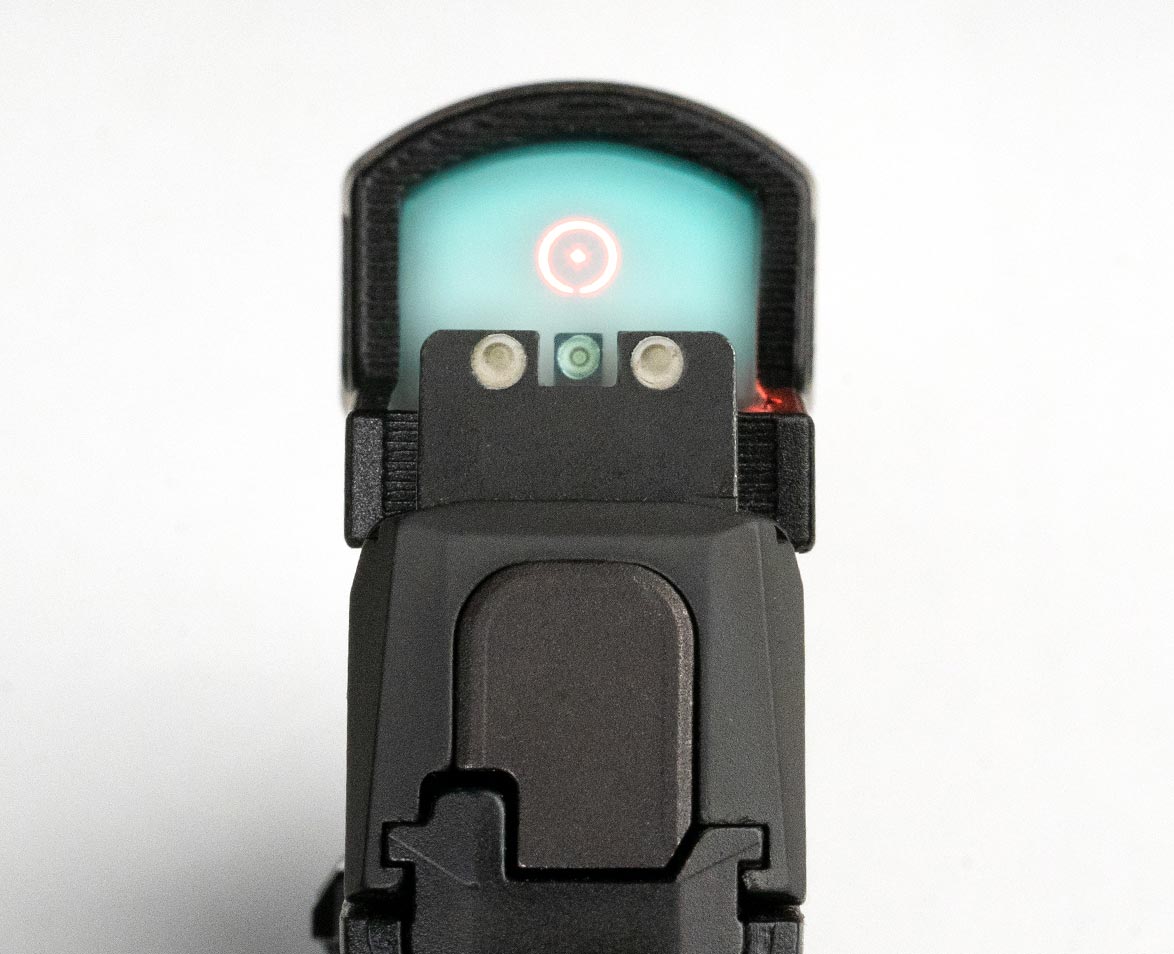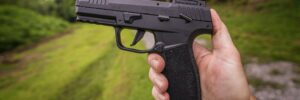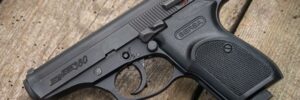A few months back, Sig Sauer released a .380 ACP version of the their bestselling P365. The P365-380 has all the same features as the original 9mm, plus an improved optic cut configuration, and more importantly, a huge reduction in felt recoil. But does it run as reliably as its 9mm counterparts?
Details are in the video below, or scroll down to read the full transcript.
Hey everybody, I am Chris Baker from LuckyGunner.com and today we’re taking a look at another Sig P365, but this one is chambered for .380 ACP.
Specs and Features
Sig introduced the .380 version earlier this year. It’s the same size as the original 9mm P365, so it’s got a 3.1-inch barrel. For now, Sig is offering three variants of the .380 model: the vanilla option with standard height iron sights, a manual safety variant, and this one, which has no manual safety, tall iron sights and it comes with the Sig RomeoZero Elite red dot sight pre-installed.
The ammo capacity is the same as the 9mm version. You get 10 rounds in the flush fitting mags, which also come with an optional extended finger rest. Or you can buy longer 12-round magazines. The .380 version is compatible with the fire control group and the grip modules from the 9mm P365s. So you can mix and match uppers and lowers like we did here. We stuck the .380 slide onto the Wilson Combat grip module we have for the 9mm XL. It works great with the 12-round mags.
You can even buy just a .380 barrel from Sig’s website. But the product page cautions that it is not compatible with the 9mm slide. The .380 slide is about a tenth of an inch shorter and slightly narrower. Unfortunately, Sig does not sell a standalone .380 slide yet. Until they do, it is not possible to convert your 9mm to a .380 without buying a complete .380 pistol.
Not a Pocket .380
You might be tempted to compare this gun to the Ruger LCP Max. That’s the .380 double-stack version of the LCP. It also has a 10+1 capacity. But the LCP Max is basically the same size as the original LCP except for the width. It’s a pocket pistol and it has the kind of harsh recoil we’ve come to expect from pocket .380s – it’s not the most pleasant gun to shoot.
I’ve been saying for a long time that .380 ACP shines brightest, not in pocket pistols, but in guns just slightly larger than that. When you move up from an LCP to something the size of a Glock 42, .380 can be a real pleasure to shoot.
The P365 is virtually the same length and height as the Glock 42. The grip is about a tenth of an inch wider. In 9mm, the original P365 is a handful. It’s not horrible to shoot for 50 or 100 rounds, but it is objectively a snappy gun.
I prefer the XL version of the P365 in 9mm because it’s easier to control. The extra couple of ounces from the longer slide and barrel cut down on recoil a bit. The longer grip gives me a little more to hang onto. But even with the XL grip frame, the challenge a lot of shooters run into, including myself, is that there’s just not quite enough room for the support hand to get in there and exert the kind of pressure we really want. Because of the tight frame dimensions, I have to practice with this specific gun fairly regularly in order to shoot it as well as I would like.
Low Recoil is for Everyone
The .380 version completely changes the equation. This gun is smaller and lighter than the XL that I have shot thousands of rounds through. It does not have any kind of special grip frame or aftermarket texture. But the first time I took it out to the range, I equaled or improved on my best performance with the 9mm XL on half a dozen different drills. The gun is so soft shooting that the crowded grip doesn’t really matter. You don’t have to get a death grip on it to keep that dot on target.
Of course, this is an advantage for newer shooters or anyone with grip strength or mobility issues. It’s also an advantage for… everyone else. It doesn’t matter how well you can run the 9mm P365, you will either shoot the .380 version better, or your performance will be the same, but with a lot less effort and practice.
And look, I know that 9mm is ballistically superior to .380 ACP. There’s no getting around that. We could debate how much or how often that really matters in the real world. I don’t think we’ll ever have a definitive answer.
What’s not debatable is that I can shoot the .380 version of this gun better. My performance is more consistent. I throw fewer shots off target. It’s just more forgiving when I’m not 100% tuned in to all the correct shooting mechanics.
Reliability
But before I get too enthusiastic about this gun, I have to consider some issues I’ve run into with other recoil operated .380s in this larger-than-pocket size category. In the past, I have been quick to recommend the Glock 42 and the Smith & Wesson EZ 380. Like the P365-380, they’re easy to shoot and, for me, they’ve been very reliable.
However, after watching other people shoot these guns and hearing from other shooters, I’ve realized that they are not quite so reliable for everyone. Some shooters – typically inexperienced shooters – oftentimes have trouble getting these .380s to cycle reliably. And from poking around online a little bit, it looks like the same is true of the P365-380.
We can get some clues as to why this is by watching the ejection pattern of the brass. The shells make kind of a gentle arc and they land a couple of feet away. Compare that to the 9mm XL where they fly out with a lot more authority. That tells me that it might not take a whole lot to keep that .380 slide from cycling completely.
So I tried shooting the gun with a loose grip. I tried holding it lower down on the frame. And sure enough, I started getting stovepipes right away.
I tried the same thing with the 9mm XL and the gun did not malfunction. In fact, I could hold the very bottom of the grip with minimal pressure, and it still cycled normally.
With the .380, if you have a sub-optimal grip or some recoil anticipation issues that cause you to move the gun as you press the trigger, you can prevent the gun from cycling. This is sometimes called limp-wristing, although that’s not an accurate description of what’s actually happening most of the time. It can happen with any recoil-operated semi-auto, but the larger-than-pocket-sized .380s seem extra susceptible to it.
When I use a normal firing grip, it cycles just fine. Just be sure to get the web of your hand as high up on the backstrap as possible, and squeeze it with no less than the pressure of a firm handshake. I know some people have had cycling issues with the P365-380 even with a good grip on the gun. It seems like some of these have a break-in period where they can be a little temperamental for the first couple hundred rounds or so, and then they run fine.
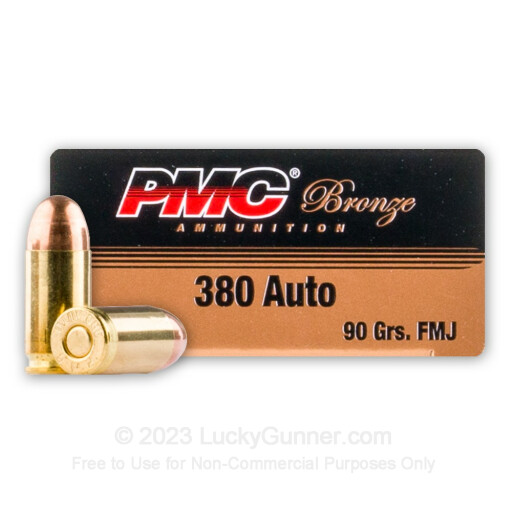
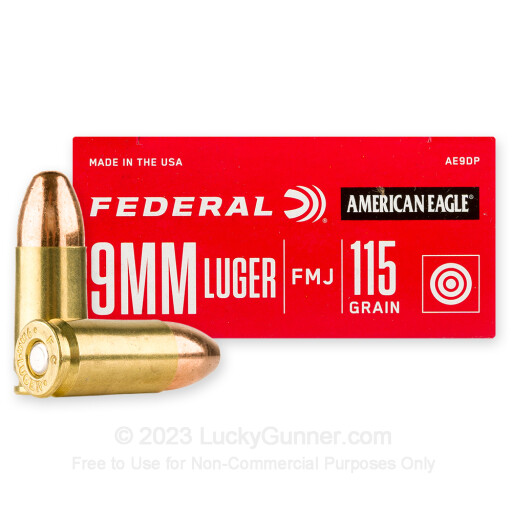
The magazines might be part of the problem there. The P365 mag springs are extremely tight. That goes for the .380 version as well as the 9mm. I’ve seen fresh mags cause feeding issues before they break in. If you leave them fully loaded for a couple of days, or load and unload them a few times, they loosen up a bit.
Ammo could also be a factor. If you can’t get it to cycle with one load, try a couple of other loads. We had two stovepipes early on with 95-grain Blazer Brass, but we switched over to 90-grain PMC, and it was fine for about 400 rounds until I tried that experiment with the weak grip.
Improved Optic Mount Setup
One feature I really like about this specific version of the P365 is the way they’ve set up the sights. Except for the .380 and a couple of the newer variants of the 9mm, mounting a red dot on a P365 meant that you lost the rear iron sight. On this version, not only has the optic been moved forward so you get to keep your rear sight, you also get the extra tall sights that co-witness with the red dot.
The standard .380 model does come with the same optic cut in the slide. So you could add an optic of your choice and install the tall sights, which Sig has on their web store for $100. Depending on the optic, that’s going to cost you no less than 200 bucks total, and possibly a lot more.
The MSRP for the .380 with the Sig optic is $750 versus $600 for the non-optic variants. That seems like a pretty good deal for an extra $150. But only if the Sig RomeoZero Elite optic is any good.
In my experience with it so far, it’s an okay optic. The reticle has a 32 MOA circle with a 3 MOA dot, but you can change that to a circle only or a dot only. I personally prefer the dot without the circle. The brightness is adjustable and I found it to be plenty bright enough for shooting outside on a sunny day. As far as using it at the range, I don’t have any complaints.
Sig claims up to 20,000 hours of runtime on a single battery with this optic. That’s a little over two years. Three months after I bought the gun, I got it out of the safe one day and the battery was dead. I removed the optic and popped in a new battery, but the optic wouldn’t turn on after I reinstalled it.
Like a lot of these smaller pistol optics, the battery fits in the bottom without any cover or door. It’s just held in place by the top of the slide. I had to shim the battery with a few pieces of tape to get it to make enough contact for the optic to turn on. I’ve had the same issue with some other pistol red dots. I think it’s a pretty major design flaw, but it’s fairly easy to fix, so just watch out for that if you own one of these.
The P365-380 has its own magazines. The body is essentially the same as the 9mm, but the follower is different and the floorplate has a spacer that runs up the spine of the mag. The 9mm magazines kind of work with the .380… sometimes. I’m not recommending it, especially for carry. But if you already have a big stash of the 9mm mags, that might be useful for practice.
Insufficient Data
Would I carry the P365-380? I’ve carried the 9mm XL off and on for the last two and a half years. The .380 is easier to carry, easier to shoot, and has excellent backup iron sights. I would love to start carrying this gun today, but I’m a little reluctant. I’ve only got about 500 rounds through it so far. It’s run fine under normal circumstances, but I’m a little troubled by how easy it was to make it malfunction.
I’d like to shoot it a lot more, try several more types of ammo, and have a few other people shoot it. I don’t want to promise anything, but if you guys are interested, I will try to bring this gun back for a long-term review sometime down the road. Just let me know what you think.
In the meantime, I hope you found some of that useful. If not, here’s one more important life tip you can use. Wait until after you get out of the shower to clip your nails. They’ll be easier to cut and the clippings won’t fly all over the room. If you want to play with rapid-moving projectiles, save that for the shooting range. And be sure you buy that ammo from us with lightning fast shipping at LuckyGunner.com.
